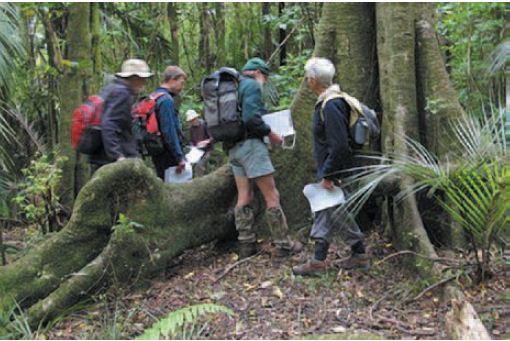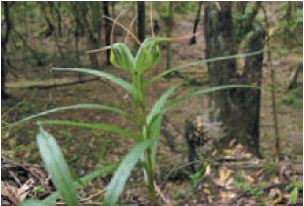Trip Report – 1 December 2012: “Te Rama”, Waikanae
We assembled in a Waikanae carpark, then drove back south in convoy, to make a safe entrance off SH 1 to this historic property, which includes a 6-ha. QEII National Trust Open Space Covenant. In earlier Maori times this commanding site, overlooking the Waikanae River, was strategically important, and even today there are clear remains of ancient storage pits, and tiers of defensive terraces, on a steep-sided spur north of owners Geoff and Louise Fishers’ house.
 |
| Plank buttresses on a pukatea. Photo: Sunita Singh. |
In a paddock near well-maintained historic farm buildings, and a huge Californian redwood, probably well over a hundred years old, Geoff gave us an informative briefing, and OSH advice, accompanied by several tui warbling aloft in a large puriri.
Soon we were off, admiring wet- site forest, where abundant nikau, pukatea, kahikatea, kiekie and kohekohe shared the canopy at c. 15-20m Plank buttresses on some pukatea were over 1 m high and 3 m long. Overhead were occasional large epiphyte nests, e.g.
Collospermum hastatum. A flourishing fern flora and prolific seedlings appeared recently after pest control by Greater Wellington Regional Council (GWRC).
Seeing how numerous the karaka seedlings were, some members commented that karaka may become a management problem here, as has happened in many other sites, such as Zealandia. It was noticeable that several forest tiers were missing or sparse, e.g. sub-canopy and ground-cover, evidence of browsing by stock and rabbits until recent times. Questions were asked about the strange growth on a young
Streblus banksii. This malformation results from predation by a tiny mite,
Eriophyes paratrophis, which punctures the plant’s cell walls, sometimes injecting hormones or enzymes which can cause the cells to proliferate like a fringe of tiny beads. (See Rob Lucas’s
Managing Pests and Diseases, page 191). By late morning we had reached an area formerly ravaged by rabbits and almost bare of seedlings but now recovering since the arrival of RCD.
 |
| Pterostylis banksii. Photo: Sunita Singh. |
After lunch we entered an area where species diversity increased markedly because stock had been excluded from it long ago. We made numerous additions here including
Adiantum diaphanum,
Hymenophyllum flexuosum, and
Arthropteris tenella. We then botanised beside the farm road which took us north, then back south towards the house. As often happens, roadside banks provided us with more additions to the list, mostly adventives, but also including
Pterostylis banksii,
Microtis unifolia,
Thelymitra sp., and
Stellaria parviflora. Later some of us botanised the spur by the house, noting an extensive planting of
Libertia cranwelliae, an East Coast endemic. Along the crest of the spur is some of the best old podocarp / broadleaf forest on the property, with big matai and miro, and one of the biggest
Olearia paniculata any of us had ever seen: triple-trunked, with a d.b.h. of c. 60 cm.
Weeds in the covenant, such as Japanese honeysuckle, climbing asparagus, pampas, banana passionfruit, wandering willie, barberry and
Adiantum raddianum need prompt attention.
We did not have time to botanise the block to the south which appeared to be covered with closed-canopy manuka and kanuka. The block is down-wind of the covenant, so with the prevailing nor’westerly, and the abundant birdlife on the property, we expect that these natural distribution processes will continue to provide a sustainable source of seeds, and thus seedlings, so that the block will evolve through natural successional stages, to a more diverse ecosystem.
Six of us were privileged to enjoy staying overnight at the beautifully fitted-out historic cottage while the rest returned to Wellington. Next day was so wet that our planned visit to Nikau Scenic Reserve was cancelled.
We thank Geoff and Louise for the privilege of visiting their fine covenant, and for their hospitality, and Mike Urlich, GWRC, for alerting us to the existence of this significant forest, and for providing a list of weeds in it.
Participants : Barbara Clark, Rae Collins, Gavin Dench, Bryan & Robin Halliday, Anthony Hill, Chris Hopkins, Priscilla Isaacs, Brenda Johnston, Leon Perrie, Graham Petterson, Nick Saville, Sunita Singh, Barbara Mitcalfe & Chris Horne (co- leaders / scribes).

 Site Index
Site Index







 Site Index
Site Index





